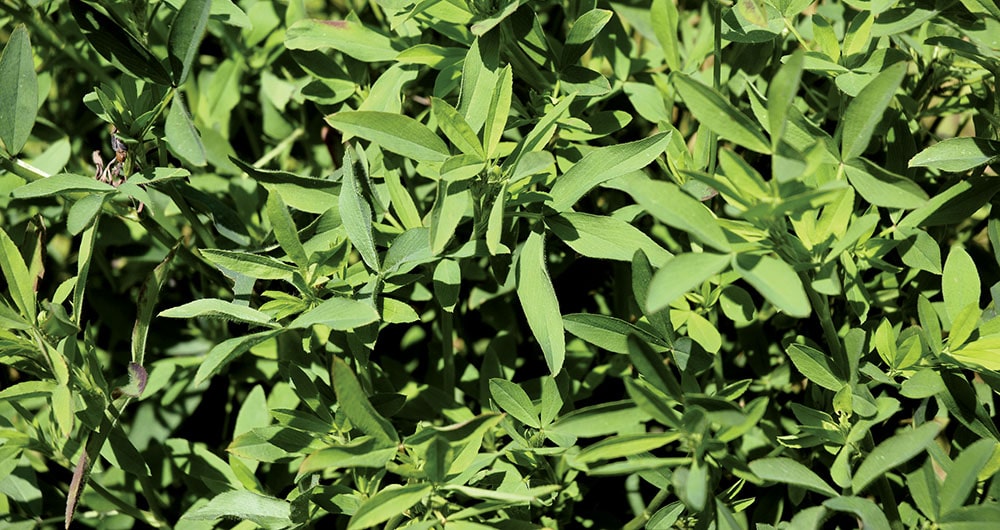In a previous post, we featured berseem clover (Trifolium alexandrinum) as a potential food plot species. The problem with berseem clover in food plots, however, is it is highly susceptible to winter kill. Many food plotters have turned their backs on the species simply due to its low cold tolerance. However, “frosty” is a somewhat new variety of berseem that is much more cold tolerant than other varieties, such as bigbee. In fact, there are some reports that frosty can withstand temperatures in the single digits. If this holds true, it will be a game changer because deer absolutely relish berseem clover, plus it quickly produces a significant amount of forage.
In the South, frosty has survived the cold very well in forage trials conducted by Mississippi State and The University of Tennessee. In east Tennessee, Dr. Craig Harper planted frosty for three consecutive years and didn’t experience any winter kill, so we know it will perform well at least in the mid-South region. However, the jury is still out further north. More research is needed in the northern states to determine if it will persist in colder climates and how well it performs under these conditions with regard to production and grazing tolerance. If these boxes can be checked, food plotters in the North can add a top-quality deer forage to their food plot regime.
Species Description
Frosty berseem clover is considered a cool-season annual legume. It has oblong-shaped leaflets that are fairly large relative to other clovers. The flowers bloom in early summer and are whitish or ivory colored. Frosty produces an abundance of nutritious forage. It can reach 2- to 3-feet tall in the spring but rarely does so because of heavy grazing pressure by deer.
Frosty prefers soils with a neutral pH (greater than 6.0) and grows well in all soil types except deep sands with low moisture retention. It is fairly tolerant of dry conditions, as well as high soil moisture. One of the best qualities of frosty is that it germinates very quickly compared to other clovers, which provides excellent early season attraction and hunting opportunities.
Frosty’s crude protein levels typically range from 20 to 30 percent and acid detergent fiber, a measure of digestibility, is below 20 percent in soils with good fertility. Because of its vigorous growth rate, berseem clover tolerates heavy grazing pressure quite well. When planted in fall, you can expect forage to be available until the following May or early June, which captures the early antler growth period.
Soil Preparation
As always, a soil test should be conducted to determine lime and fertilizer requirements specific to clover. Because berseem clover is a legume and can produce 150 to 200 lbs./acre of nitrogen, little nitrogen is needed for establishment. Applying additional phosphorus and potassium is important and should be applied at levels recommended from a soil test for optimum production, attraction and nutritional quality.
Planting
Frosty is easy to establish and can either be broadcast at 20 to 25 lbs./acre into a well-prepared seedbed or drilled at 12 to 14 lbs./acre with a no-till drill. In the South, plant in September or October. In northern states, plant in early August or in the spring as a summer crop after danger of frost has passed. This interactive map of planting dates will help you dial in even more accurately on the best timing.

Because it is a legume, berseem clover should be inoculated (strain R, same as crimson) prior to planting unless using pre-inoculated seed. If broadcasting seed, be sure to prepare a smooth, firm seedbed to ensure optimum germination and seedling establishment. Seeds are very small so be sure the field is free of deep furrows from disking and large clods/debris to prevent covering too deep. Cultipacking prior to sowing the seed will assist with achieving the ideal seedbed and enhance germination. Loose soil will reduce germination.
When covering the seed, be sure it isn’t buried more than 1/4-inch deep. If rain is in the forecast (as it should be if you are planting!), you can simply allow the rainfall to work the seed into the soil. If a dependable rain is not in the forecast, cultipack the field again to press seed firmly into the soil for good contact. If no-till planting, be sure to kill the existing vegetation with glyphosate a couple weeks prior to planting to eliminate weed competition.
More Details
I provided more details about frosty berseem clover in the full profile in Quality Whitetails magazine. To start receiving Quality Whitetails, become a member of NDA today.
